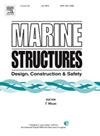颗粒阻尼抑制不同分支涡激振动的实验与理论研究
IF 4
2区 工程技术
Q1 ENGINEERING, CIVIL
引用次数: 0
摘要
虽然颗粒阻尼已被证明是一种有效的被动振动控制技术,广泛应用于各种行业,但其在海洋结构中抑制涡激振动(VIV)的有效性和机制研究尚不清楚。本文采用实验与理论相结合的方法,研究了颗粒阻尼器对圆柱体不同分支的振动影响,确定了颗粒阻尼器抑制振动的规律和机理。本研究得出的主要结论包括:1。不同的涡激振荡分支的最佳填充比不同,在填充率约为85%时,总体涡激振荡抑制效果最高,从而导致幅度抑制比为30% - 40%。2. 粒子阻尼器对涡激振动具有调幅效应,能够激发与静止圆柱涡落频率相同的振动模式。此外,本文还基于实验结果和理论模型对颗粒阻尼系统进行了参数化研究。研究结果证明了在海洋工程结构中应用粒子阻尼抑制涡激振动的可行性,为粒子阻尼器的优化参数选择提供了有价值的参考。本文章由计算机程序翻译,如有差异,请以英文原文为准。
Experimental and theoretical studies of particle damping for the suppression of vortex-induced vibrations in different branches
Although particle damping has proven to be an effective passive vibration control technique widely applied across a variety of industries, research on its effectiveness and mechanism for suppressing vortex-induced vibrations (VIV) in marine structures remains unclear. This paper investigates the effects of particle dampers on VIV in different branches of a cylinder, determining rules and mechanisms of vibration suppression through a combination of experimental and theoretical analysis methods. Key conclusions drawn from our study include: 1. Optimal filling ratios vary for different VIV branches, with the highest overall VIV suppression effect at a filling rate of approximately 85 %, resulting in amplitude suppression ratios of 30 %-40 %. 2. Particle dampers exhibit an amplitude modulation effect on VIV, with the ability to excite a vibration mode that has the same frequency as the vortex shedding frequency of stationary cylinders. Furthermore, a parameterized study of particle damping systems is conducted in this paper, based on experimental results and theoretical models. Our findings demonstrate the feasibility of applying particle damping to suppress VIV in marine engineering structures, providing valuable reference for selecting optimal parameters of particle dampers.
求助全文
通过发布文献求助,成功后即可免费获取论文全文。
去求助
来源期刊

Marine Structures
工程技术-工程:海洋
CiteScore
8.70
自引率
7.70%
发文量
157
审稿时长
6.4 months
期刊介绍:
This journal aims to provide a medium for presentation and discussion of the latest developments in research, design, fabrication and in-service experience relating to marine structures, i.e., all structures of steel, concrete, light alloy or composite construction having an interface with the sea, including ships, fixed and mobile offshore platforms, submarine and submersibles, pipelines, subsea systems for shallow and deep ocean operations and coastal structures such as piers.
 求助内容:
求助内容: 应助结果提醒方式:
应助结果提醒方式:


